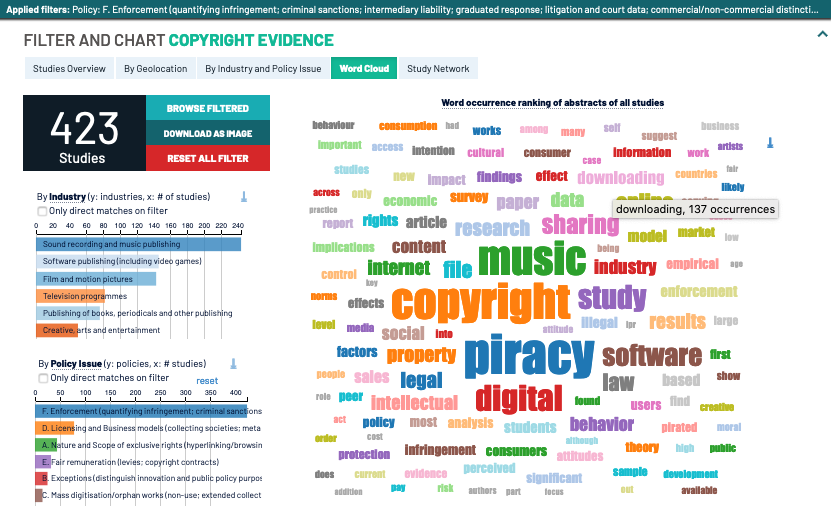The Copyright Evidence Portal is now live. It gives access to the world’s current knowledge about copyright law and its effects – both as a data-minable Wiki catalogue and through visualizations.
The Portal was publicly launched at BEYOND 2020, a conference that brings together thinkers, makers, investors and researchers across the creative industries to explore the relationship between creative research and business innovation. During the session ‘Text and Data Mining of Copyright Evidence: Vizualisation R&D and Deep Dive by CREATe’, Amy Thomas, Bartolomeo Meletti, Kris Erickson and Martin Kretschmer presented the new Portal and showcased its potential by answering live questions with the Copyright Evidence Wiki and the new Evidence Viz tool.
The Copyright Evidence Portal – funded by the AHRC Creative Industries Policy & Evidence Centre (PEC) and designed by Pete Bennett – is the latest development of the CREATe Evidence project. This blog provides an overview of the launch event, including the inspiration behind the project and its key components.
Speaking to the motivation behind the project, Martin and Kris reflected on 25 years of perpetual crisis in copyright law. Following the moral panic surrounding piracy in the mid-1990s, copyright is no longer a closed environment in the sole remit of lawyers, but rather a topic of central interest to the infrastructure of the creative industries.
This shift brought with it the sudden need for evidence on the effects that copyright has on society, and the realisation that, until now, no such central evidence resource exists. With this brings the risk that copyright policy and public debate becomes informed by myths and anecdotes, rather than rigorous evidence. One of the primary goals of the CREATe centre is to change this.
With this goal in mind, CREATe has developed the Copyright Evidence Wiki, a centralised resource cataloguing the state of knowledge and evidence on copyright’s effects on society. Utilising Wikimedia technologies, the Evidence Wiki envisions a platform of transparency, openness to review and a user-led orientation. Coupled with a large editorial board ensuring external peer-review, the Wiki ensures ‘built in’ robustness in this often-contested policy area.
Being, at the time of its inception, a new discipline with a relatively small pool of studies, our goal has never been anything less than to construct a complete body of knowledge (today cataloguing over 800 studies). This is achieved through a broad, multidisciplinary appreciation of evidence sources, including studies from psychology, economics, computer science and many other disciplinary fields.
During the launch event, Amy presented an overview of the Copyright Evidence Wiki, demonstrating its organisation into searchable and filterable thematic categories, including policy issues, industries and methodology, amongst others. Being fully text and data minable, the Wiki is also resilient to new technologies and topical issues, such as artificial intelligence or platform liability, making this a dynamic and adaptable research tool.
Reflecting on what this corpus of evidence represents, our emphasis now lies on making the data within the Evidence Wiki useful and actionable for all stakeholders – creators, consumers, businesses, researchers and policy makers.
To this end, Bart showcased the new Evidence Viz tool, developed by Dietmar Aumann. The tool is designed to help detect trends and patterns across the over 800 studies currently catalogued on the Wiki. It interrogates the Wiki database every time it is opened on a browser, so if new studies are added to the Wiki, they are automatically captured by the visualisation tool. The tool is organised in five tabs:
- Studies overview: provides a snapshot of the empirical studies available on the Wiki and in particular of the jurisdictions, policy issues and industries that the studies refer to, as well as a timeline of publication.
- Geolocation: allows users to navigate the Wiki starting from specific jurisdictions.
- Industry and Policy Issue: enables users to search for studies relating to specific industries and policy issues; it includes a Method pie chart showing the methods of data collection and analysis adopted in the filtered studies.
- Word Cloud: visualises which words occur more often in the abstracts of the catalogued studies; the word cloud can be filtered by industry and policy issue.
- Study network: two alternative visualisations (node and chord) of the top referenced studies in the Wiki, which can be filtered by number of references. Disclaimer: the study network visualisations only capture references made by other studies catalogued in the Wiki.

Evidence Viz: Word cloud showing the most recurrent words in the abstracts of the 421 empirical studies relating to Enforcement.
The session generated a lively discussion and interesting questions on co-creation, business models and the metaverse, among other things. The questions that due to time constraints have not been answered live during the BEYOND session have been addressed in this Twitter thread.
We would also like to thank participants at the Creative Commons 2020 summit, for their thoughtful feedback and concept testing of the beta version of the Evidence Portal.
The Evidence Project continues to grow, with many exciting developments scheduled for 2021 – be sure to subscribe to our newsletter and follow us on Twitter for more updates!



